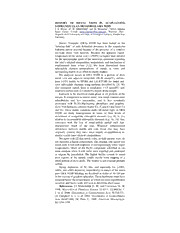
NASA Technical Reports Server (NTRS) 20060024503: History of Metal Veins in Acapulcoite-Lodranite Clan Meteorite GRA 95209 PDF
Preview NASA Technical Reports Server (NTRS) 20060024503: History of Metal Veins in Acapulcoite-Lodranite Clan Meteorite GRA 95209
HISTORY OF METAL VEINS IN ACAPULCOITE- LODRANITE CLAN METEORITE GRA 95209. J. S. Herrin1, D. W. Mittlefehldt1, and M. Humayun2. 1NASA Johnson Space Center. E-mail: [email protected] 2National High Magnetic Field Laboratory and Dept. of Geological Sciences, Florida State University. Graves Nunataks (GRA) 95209 has been hailed as the “missing link” of core formation processes in the acapulcoite- lodranite parent asteroid because of the presence of a complex cm-scale metal vein network. Because the apparent liquid temperature of the metal vein (~1500ºC) is higher than inferred for the metamorphic grade of the meteorite, questions regarding the vein’s original composition, temperature, and mechanism of emplacement have arisen [1,2]. We have determined trace siderophile element compositions of metals in veins and surrounding matrix in an effort to clarify matters. We analyzed metals in GRA 95209 in a portion of thick metal vein and adjacent metal-rich (30-40 modal%), sulfide- poor (<1%) matrix by EPMA and LA-ICP-MS for major and trace siderophile elements using methods described by [3]. We also examined metals from a metal-poor (~15 modal%) and relatively sulfide-rich (2-5 modal%) region of the sample. Kamacite is the dominant metal phase in all portions of the sample. In comparison to matrix metal, vein metal contains more schreibersite and less tetrataenite, and is less commonly associated with Fe,Mn,Mg-bearing phosphates and graphite [2,4]. Vein kamacite contains higher Co, P, and Cr and lower Cu and Ge. These minor variations aside, all metal types in GRA 95209 are fairly homogeneous in terms of their levels of enrichment of compatible siderophile elements (e.g. Pt, Ir, Os) relative to incompatible siderophile elements (e.g. As, Pd, Au), consistent with the loss of metal-sulfide partial melt that characterizes much of the clan. Whatever compositional differences between matrix and vein metal that may have originally existed, they have since largely co-equilibrated to similar restitic trace element compositions. We agree with [2] that metal veins, in their present state, do not represent a liquid composition. The original vein liquid was much more S-rich and emplaced at correspondingly lower liquid temperatures. Much of the Fe,Ni component solidified in cm- scale conduits while S-rich melts were expelled and continued to migrate by percolation. The higher troilite content in metal- poor regions of the sample results mostly from trapping of a small portion of these melts. The troilite is not remnant primary sulfide. Strong depletions of W, Mo, and especially Ga (>50%, >60%, and >90% depletion, respectively) in metals of the metal- poor GRA 95209 lithology are localized at scales of 10-100 µm in the vicinity of graphite spherules. These depletions must have occurred below the temperatures at which cm-scale equilibration occurred, and future work will seek to determine their cause. References: [1] Mittlefehldt D. W. and Lindstrom M. M. 1998. Meteoritics & Planetary Science 33:A111. [2] McCoy T. J. et al. 2006. Geochimica et Cosmochimica Acta 70:516-531. [3] Campbell A. J. et al. 2002. Geochimica et Cosmochimica Acta 66:647-660. [4] Floss C. 1999. American Mineralogist 84:1354-1359.
